Economics: International Markets Institutions and Policies
VerifiedAdded on 2023/05/31
|12
|2949
|267
AI Summary
This article discusses the impact of regional trade agreements like NAFTA and ASEAN on global economy. It explores their objectives, benefits and criticisms. The article also provides a brief history of these agreements and their impact on member countries.
Contribute Materials
Your contribution can guide someone’s learning journey. Share your
documents today.
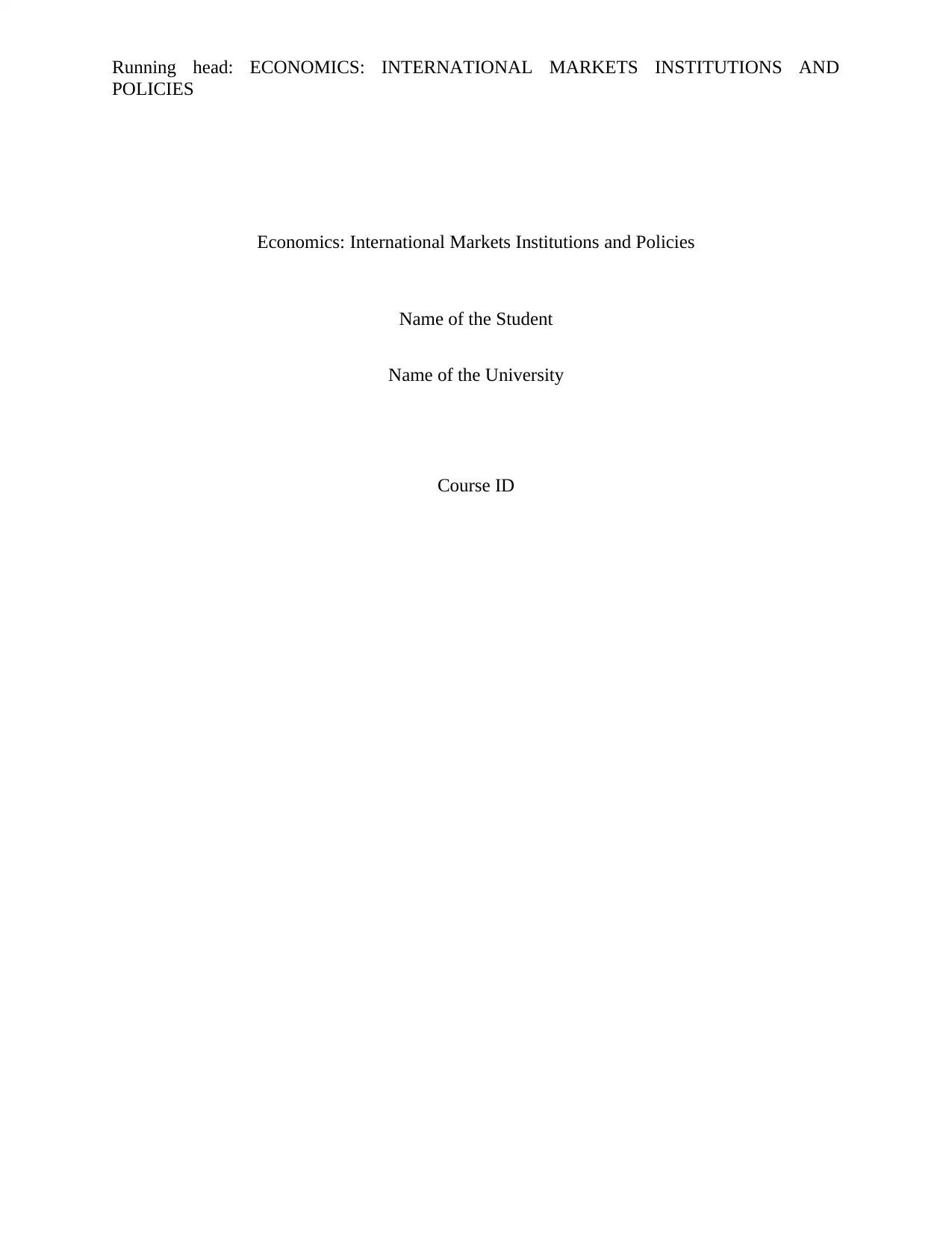
Running head: ECONOMICS: INTERNATIONAL MARKETS INSTITUTIONS AND
POLICIES
Economics: International Markets Institutions and Policies
Name of the Student
Name of the University
Course ID
POLICIES
Economics: International Markets Institutions and Policies
Name of the Student
Name of the University
Course ID
Secure Best Marks with AI Grader
Need help grading? Try our AI Grader for instant feedback on your assignments.
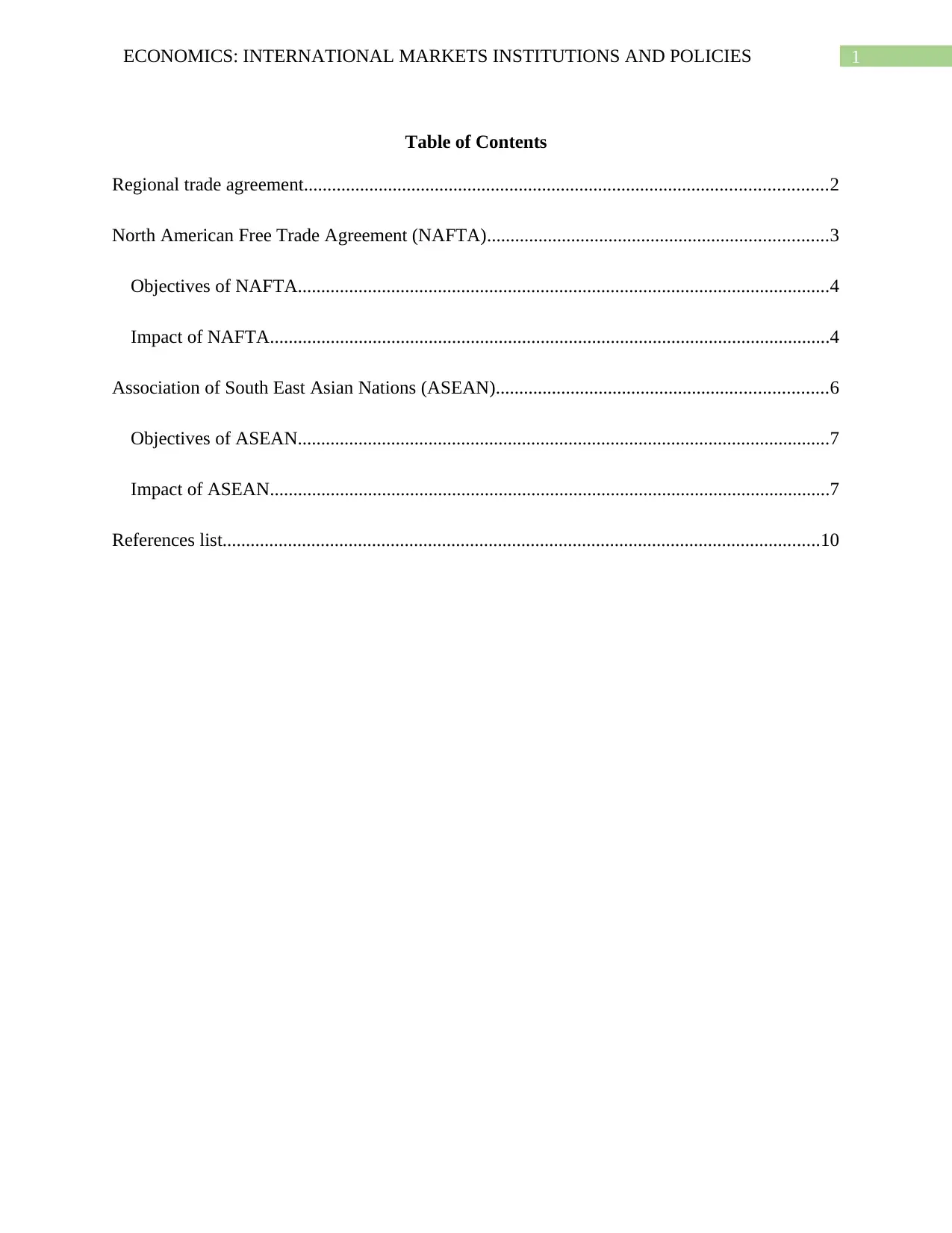
1ECONOMICS: INTERNATIONAL MARKETS INSTITUTIONS AND POLICIES
Table of Contents
Regional trade agreement................................................................................................................2
North American Free Trade Agreement (NAFTA).........................................................................3
Objectives of NAFTA..................................................................................................................4
Impact of NAFTA........................................................................................................................4
Association of South East Asian Nations (ASEAN).......................................................................6
Objectives of ASEAN..................................................................................................................7
Impact of ASEAN........................................................................................................................7
References list................................................................................................................................10
Table of Contents
Regional trade agreement................................................................................................................2
North American Free Trade Agreement (NAFTA).........................................................................3
Objectives of NAFTA..................................................................................................................4
Impact of NAFTA........................................................................................................................4
Association of South East Asian Nations (ASEAN).......................................................................6
Objectives of ASEAN..................................................................................................................7
Impact of ASEAN........................................................................................................................7
References list................................................................................................................................10
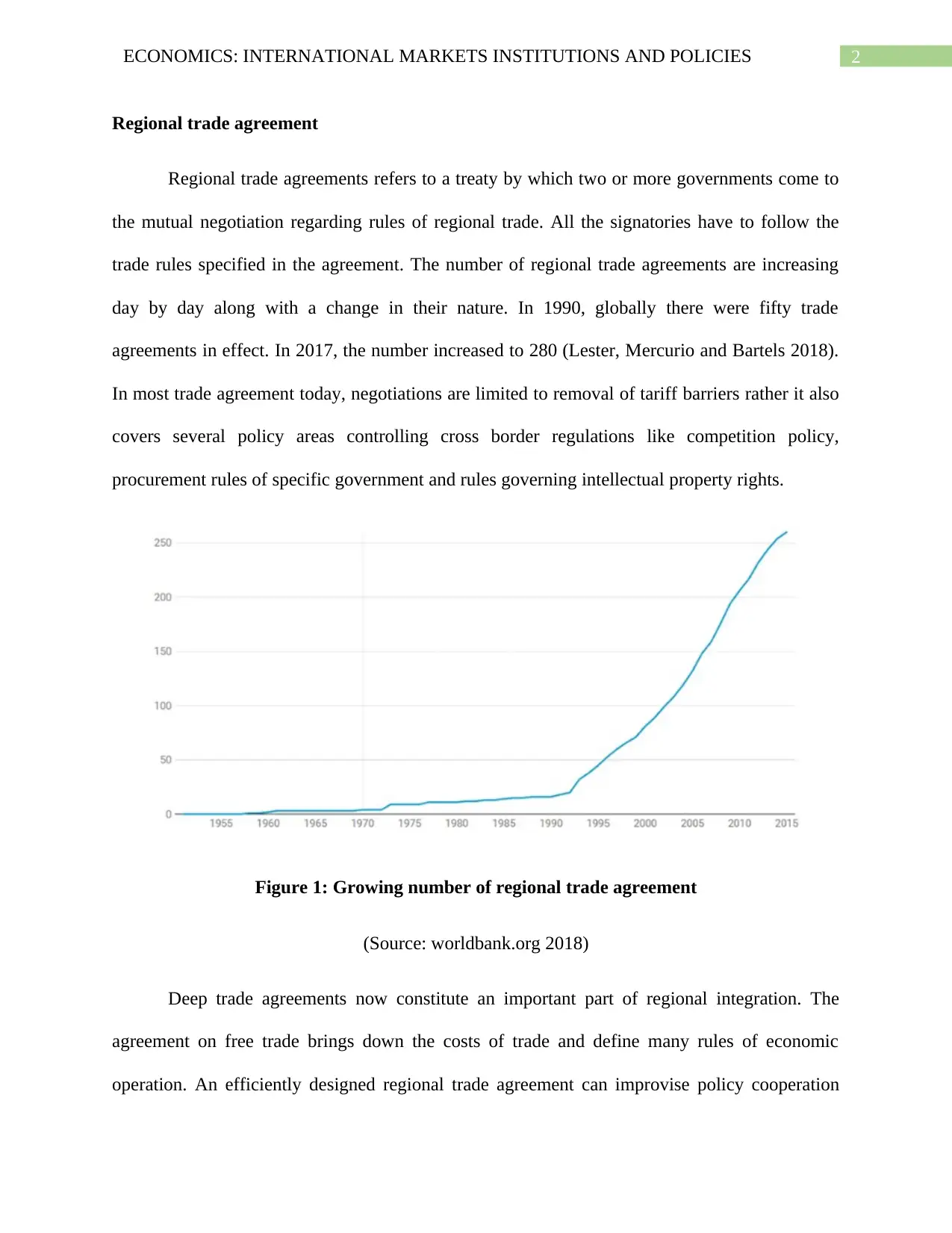
2ECONOMICS: INTERNATIONAL MARKETS INSTITUTIONS AND POLICIES
Regional trade agreement
Regional trade agreements refers to a treaty by which two or more governments come to
the mutual negotiation regarding rules of regional trade. All the signatories have to follow the
trade rules specified in the agreement. The number of regional trade agreements are increasing
day by day along with a change in their nature. In 1990, globally there were fifty trade
agreements in effect. In 2017, the number increased to 280 (Lester, Mercurio and Bartels 2018).
In most trade agreement today, negotiations are limited to removal of tariff barriers rather it also
covers several policy areas controlling cross border regulations like competition policy,
procurement rules of specific government and rules governing intellectual property rights.
Figure 1: Growing number of regional trade agreement
(Source: worldbank.org 2018)
Deep trade agreements now constitute an important part of regional integration. The
agreement on free trade brings down the costs of trade and define many rules of economic
operation. An efficiently designed regional trade agreement can improvise policy cooperation
Regional trade agreement
Regional trade agreements refers to a treaty by which two or more governments come to
the mutual negotiation regarding rules of regional trade. All the signatories have to follow the
trade rules specified in the agreement. The number of regional trade agreements are increasing
day by day along with a change in their nature. In 1990, globally there were fifty trade
agreements in effect. In 2017, the number increased to 280 (Lester, Mercurio and Bartels 2018).
In most trade agreement today, negotiations are limited to removal of tariff barriers rather it also
covers several policy areas controlling cross border regulations like competition policy,
procurement rules of specific government and rules governing intellectual property rights.
Figure 1: Growing number of regional trade agreement
(Source: worldbank.org 2018)
Deep trade agreements now constitute an important part of regional integration. The
agreement on free trade brings down the costs of trade and define many rules of economic
operation. An efficiently designed regional trade agreement can improvise policy cooperation
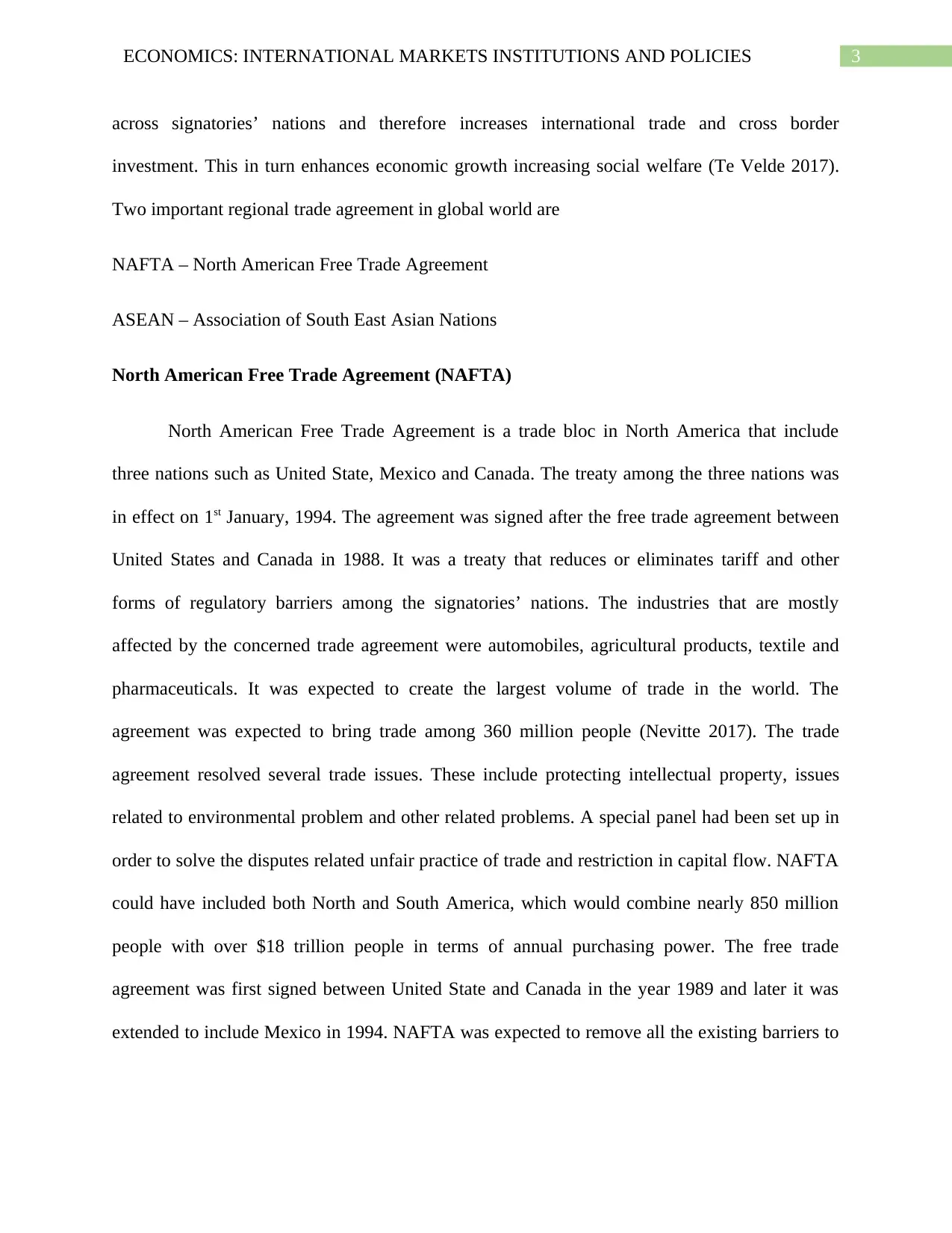
3ECONOMICS: INTERNATIONAL MARKETS INSTITUTIONS AND POLICIES
across signatories’ nations and therefore increases international trade and cross border
investment. This in turn enhances economic growth increasing social welfare (Te Velde 2017).
Two important regional trade agreement in global world are
NAFTA – North American Free Trade Agreement
ASEAN – Association of South East Asian Nations
North American Free Trade Agreement (NAFTA)
North American Free Trade Agreement is a trade bloc in North America that include
three nations such as United State, Mexico and Canada. The treaty among the three nations was
in effect on 1st January, 1994. The agreement was signed after the free trade agreement between
United States and Canada in 1988. It was a treaty that reduces or eliminates tariff and other
forms of regulatory barriers among the signatories’ nations. The industries that are mostly
affected by the concerned trade agreement were automobiles, agricultural products, textile and
pharmaceuticals. It was expected to create the largest volume of trade in the world. The
agreement was expected to bring trade among 360 million people (Nevitte 2017). The trade
agreement resolved several trade issues. These include protecting intellectual property, issues
related to environmental problem and other related problems. A special panel had been set up in
order to solve the disputes related unfair practice of trade and restriction in capital flow. NAFTA
could have included both North and South America, which would combine nearly 850 million
people with over $18 trillion people in terms of annual purchasing power. The free trade
agreement was first signed between United State and Canada in the year 1989 and later it was
extended to include Mexico in 1994. NAFTA was expected to remove all the existing barriers to
across signatories’ nations and therefore increases international trade and cross border
investment. This in turn enhances economic growth increasing social welfare (Te Velde 2017).
Two important regional trade agreement in global world are
NAFTA – North American Free Trade Agreement
ASEAN – Association of South East Asian Nations
North American Free Trade Agreement (NAFTA)
North American Free Trade Agreement is a trade bloc in North America that include
three nations such as United State, Mexico and Canada. The treaty among the three nations was
in effect on 1st January, 1994. The agreement was signed after the free trade agreement between
United States and Canada in 1988. It was a treaty that reduces or eliminates tariff and other
forms of regulatory barriers among the signatories’ nations. The industries that are mostly
affected by the concerned trade agreement were automobiles, agricultural products, textile and
pharmaceuticals. It was expected to create the largest volume of trade in the world. The
agreement was expected to bring trade among 360 million people (Nevitte 2017). The trade
agreement resolved several trade issues. These include protecting intellectual property, issues
related to environmental problem and other related problems. A special panel had been set up in
order to solve the disputes related unfair practice of trade and restriction in capital flow. NAFTA
could have included both North and South America, which would combine nearly 850 million
people with over $18 trillion people in terms of annual purchasing power. The free trade
agreement was first signed between United State and Canada in the year 1989 and later it was
extended to include Mexico in 1994. NAFTA was expected to remove all the existing barriers to
Secure Best Marks with AI Grader
Need help grading? Try our AI Grader for instant feedback on your assignments.

4ECONOMICS: INTERNATIONAL MARKETS INSTITUTIONS AND POLICIES
trade among the three nations. Having a population of 363 million NAFTA captures one
significant area of trade in global market.
Objectives of NAFTA
The regional trade agreement was signed to accomplish the following objectives
Creating new opportunities for business especially in Mexico.
Developing competitive advantage for companies operating in US, Canada and Mexico
and in broader international market.
Reducing price of different goods and services
Enhancement of industrial development, which would create employment opportunities
in these regions.
Ensure a stable political environment to boost confidence of investors (Rugman and
Verbeke 2017)
Development of industries in Mexico with the objective of creating employment
opportunities so that migration from Mexico to USA can be reduced.
Assist Mexico to earn more foreign exchange, which help the nation to reduce the burden
of foreign debt.
Improvement and consolidation of political economic relationship among the countries
Impact of NAFTA
Canada
As of 2008, the export of Canada to United State and Mexico accounted to be $381.3
billion. The value of import of Canada from the two member nations was $245.1 billion. NAFTA
produced considerable benefits to Canada in the year 2003. Industries in Canada that experienced
trade among the three nations. Having a population of 363 million NAFTA captures one
significant area of trade in global market.
Objectives of NAFTA
The regional trade agreement was signed to accomplish the following objectives
Creating new opportunities for business especially in Mexico.
Developing competitive advantage for companies operating in US, Canada and Mexico
and in broader international market.
Reducing price of different goods and services
Enhancement of industrial development, which would create employment opportunities
in these regions.
Ensure a stable political environment to boost confidence of investors (Rugman and
Verbeke 2017)
Development of industries in Mexico with the objective of creating employment
opportunities so that migration from Mexico to USA can be reduced.
Assist Mexico to earn more foreign exchange, which help the nation to reduce the burden
of foreign debt.
Improvement and consolidation of political economic relationship among the countries
Impact of NAFTA
Canada
As of 2008, the export of Canada to United State and Mexico accounted to be $381.3
billion. The value of import of Canada from the two member nations was $245.1 billion. NAFTA
produced considerable benefits to Canada in the year 2003. Industries in Canada that experienced
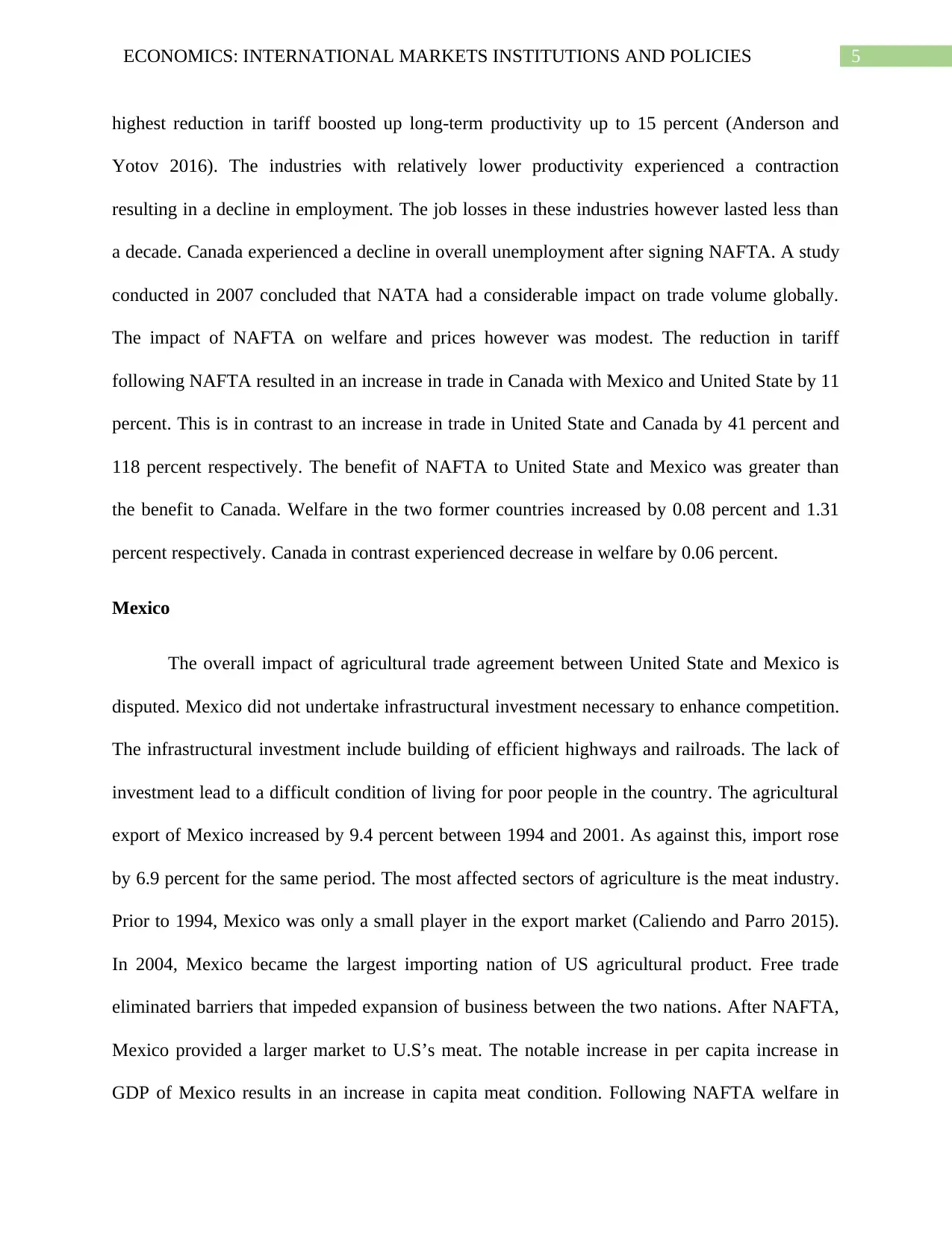
5ECONOMICS: INTERNATIONAL MARKETS INSTITUTIONS AND POLICIES
highest reduction in tariff boosted up long-term productivity up to 15 percent (Anderson and
Yotov 2016). The industries with relatively lower productivity experienced a contraction
resulting in a decline in employment. The job losses in these industries however lasted less than
a decade. Canada experienced a decline in overall unemployment after signing NAFTA. A study
conducted in 2007 concluded that NATA had a considerable impact on trade volume globally.
The impact of NAFTA on welfare and prices however was modest. The reduction in tariff
following NAFTA resulted in an increase in trade in Canada with Mexico and United State by 11
percent. This is in contrast to an increase in trade in United State and Canada by 41 percent and
118 percent respectively. The benefit of NAFTA to United State and Mexico was greater than
the benefit to Canada. Welfare in the two former countries increased by 0.08 percent and 1.31
percent respectively. Canada in contrast experienced decrease in welfare by 0.06 percent.
Mexico
The overall impact of agricultural trade agreement between United State and Mexico is
disputed. Mexico did not undertake infrastructural investment necessary to enhance competition.
The infrastructural investment include building of efficient highways and railroads. The lack of
investment lead to a difficult condition of living for poor people in the country. The agricultural
export of Mexico increased by 9.4 percent between 1994 and 2001. As against this, import rose
by 6.9 percent for the same period. The most affected sectors of agriculture is the meat industry.
Prior to 1994, Mexico was only a small player in the export market (Caliendo and Parro 2015).
In 2004, Mexico became the largest importing nation of US agricultural product. Free trade
eliminated barriers that impeded expansion of business between the two nations. After NAFTA,
Mexico provided a larger market to U.S’s meat. The notable increase in per capita increase in
GDP of Mexico results in an increase in capita meat condition. Following NAFTA welfare in
highest reduction in tariff boosted up long-term productivity up to 15 percent (Anderson and
Yotov 2016). The industries with relatively lower productivity experienced a contraction
resulting in a decline in employment. The job losses in these industries however lasted less than
a decade. Canada experienced a decline in overall unemployment after signing NAFTA. A study
conducted in 2007 concluded that NATA had a considerable impact on trade volume globally.
The impact of NAFTA on welfare and prices however was modest. The reduction in tariff
following NAFTA resulted in an increase in trade in Canada with Mexico and United State by 11
percent. This is in contrast to an increase in trade in United State and Canada by 41 percent and
118 percent respectively. The benefit of NAFTA to United State and Mexico was greater than
the benefit to Canada. Welfare in the two former countries increased by 0.08 percent and 1.31
percent respectively. Canada in contrast experienced decrease in welfare by 0.06 percent.
Mexico
The overall impact of agricultural trade agreement between United State and Mexico is
disputed. Mexico did not undertake infrastructural investment necessary to enhance competition.
The infrastructural investment include building of efficient highways and railroads. The lack of
investment lead to a difficult condition of living for poor people in the country. The agricultural
export of Mexico increased by 9.4 percent between 1994 and 2001. As against this, import rose
by 6.9 percent for the same period. The most affected sectors of agriculture is the meat industry.
Prior to 1994, Mexico was only a small player in the export market (Caliendo and Parro 2015).
In 2004, Mexico became the largest importing nation of US agricultural product. Free trade
eliminated barriers that impeded expansion of business between the two nations. After NAFTA,
Mexico provided a larger market to U.S’s meat. The notable increase in per capita increase in
GDP of Mexico results in an increase in capita meat condition. Following NAFTA welfare in
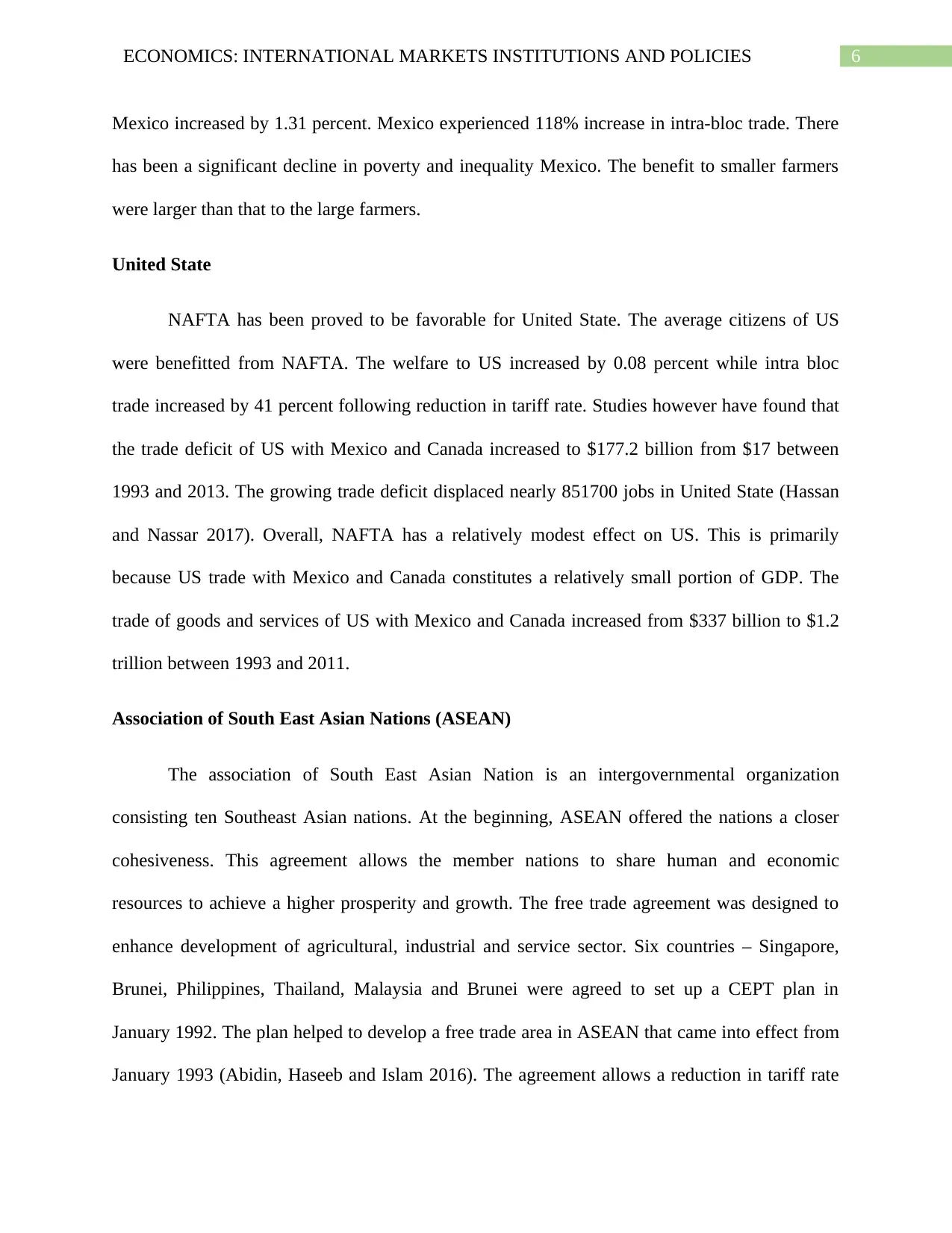
6ECONOMICS: INTERNATIONAL MARKETS INSTITUTIONS AND POLICIES
Mexico increased by 1.31 percent. Mexico experienced 118% increase in intra-bloc trade. There
has been a significant decline in poverty and inequality Mexico. The benefit to smaller farmers
were larger than that to the large farmers.
United State
NAFTA has been proved to be favorable for United State. The average citizens of US
were benefitted from NAFTA. The welfare to US increased by 0.08 percent while intra bloc
trade increased by 41 percent following reduction in tariff rate. Studies however have found that
the trade deficit of US with Mexico and Canada increased to $177.2 billion from $17 between
1993 and 2013. The growing trade deficit displaced nearly 851700 jobs in United State (Hassan
and Nassar 2017). Overall, NAFTA has a relatively modest effect on US. This is primarily
because US trade with Mexico and Canada constitutes a relatively small portion of GDP. The
trade of goods and services of US with Mexico and Canada increased from $337 billion to $1.2
trillion between 1993 and 2011.
Association of South East Asian Nations (ASEAN)
The association of South East Asian Nation is an intergovernmental organization
consisting ten Southeast Asian nations. At the beginning, ASEAN offered the nations a closer
cohesiveness. This agreement allows the member nations to share human and economic
resources to achieve a higher prosperity and growth. The free trade agreement was designed to
enhance development of agricultural, industrial and service sector. Six countries – Singapore,
Brunei, Philippines, Thailand, Malaysia and Brunei were agreed to set up a CEPT plan in
January 1992. The plan helped to develop a free trade area in ASEAN that came into effect from
January 1993 (Abidin, Haseeb and Islam 2016). The agreement allows a reduction in tariff rate
Mexico increased by 1.31 percent. Mexico experienced 118% increase in intra-bloc trade. There
has been a significant decline in poverty and inequality Mexico. The benefit to smaller farmers
were larger than that to the large farmers.
United State
NAFTA has been proved to be favorable for United State. The average citizens of US
were benefitted from NAFTA. The welfare to US increased by 0.08 percent while intra bloc
trade increased by 41 percent following reduction in tariff rate. Studies however have found that
the trade deficit of US with Mexico and Canada increased to $177.2 billion from $17 between
1993 and 2013. The growing trade deficit displaced nearly 851700 jobs in United State (Hassan
and Nassar 2017). Overall, NAFTA has a relatively modest effect on US. This is primarily
because US trade with Mexico and Canada constitutes a relatively small portion of GDP. The
trade of goods and services of US with Mexico and Canada increased from $337 billion to $1.2
trillion between 1993 and 2011.
Association of South East Asian Nations (ASEAN)
The association of South East Asian Nation is an intergovernmental organization
consisting ten Southeast Asian nations. At the beginning, ASEAN offered the nations a closer
cohesiveness. This agreement allows the member nations to share human and economic
resources to achieve a higher prosperity and growth. The free trade agreement was designed to
enhance development of agricultural, industrial and service sector. Six countries – Singapore,
Brunei, Philippines, Thailand, Malaysia and Brunei were agreed to set up a CEPT plan in
January 1992. The plan helped to develop a free trade area in ASEAN that came into effect from
January 1993 (Abidin, Haseeb and Islam 2016). The agreement allows a reduction in tariff rate
Paraphrase This Document
Need a fresh take? Get an instant paraphrase of this document with our AI Paraphraser
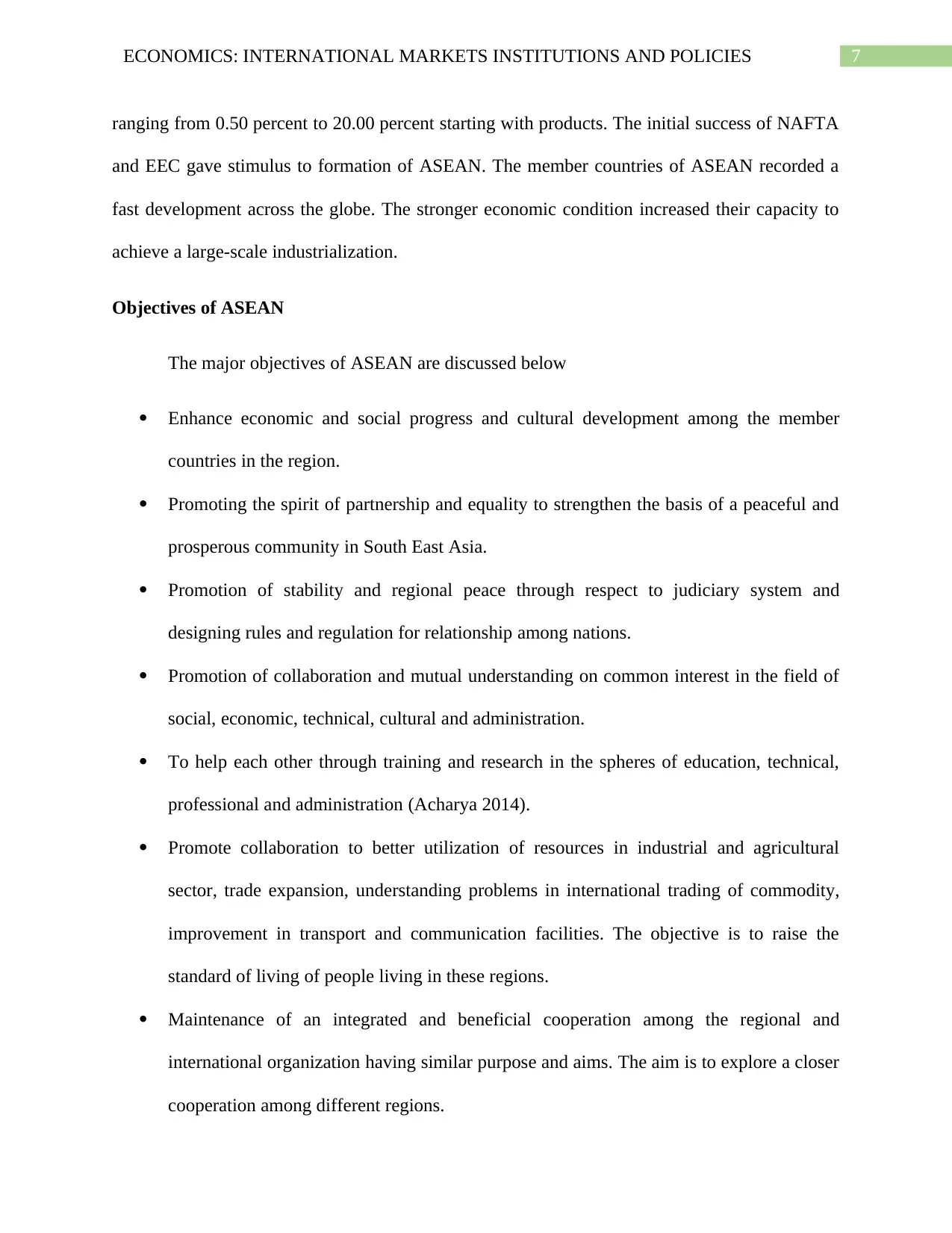
7ECONOMICS: INTERNATIONAL MARKETS INSTITUTIONS AND POLICIES
ranging from 0.50 percent to 20.00 percent starting with products. The initial success of NAFTA
and EEC gave stimulus to formation of ASEAN. The member countries of ASEAN recorded a
fast development across the globe. The stronger economic condition increased their capacity to
achieve a large-scale industrialization.
Objectives of ASEAN
The major objectives of ASEAN are discussed below
Enhance economic and social progress and cultural development among the member
countries in the region.
Promoting the spirit of partnership and equality to strengthen the basis of a peaceful and
prosperous community in South East Asia.
Promotion of stability and regional peace through respect to judiciary system and
designing rules and regulation for relationship among nations.
Promotion of collaboration and mutual understanding on common interest in the field of
social, economic, technical, cultural and administration.
To help each other through training and research in the spheres of education, technical,
professional and administration (Acharya 2014).
Promote collaboration to better utilization of resources in industrial and agricultural
sector, trade expansion, understanding problems in international trading of commodity,
improvement in transport and communication facilities. The objective is to raise the
standard of living of people living in these regions.
Maintenance of an integrated and beneficial cooperation among the regional and
international organization having similar purpose and aims. The aim is to explore a closer
cooperation among different regions.
ranging from 0.50 percent to 20.00 percent starting with products. The initial success of NAFTA
and EEC gave stimulus to formation of ASEAN. The member countries of ASEAN recorded a
fast development across the globe. The stronger economic condition increased their capacity to
achieve a large-scale industrialization.
Objectives of ASEAN
The major objectives of ASEAN are discussed below
Enhance economic and social progress and cultural development among the member
countries in the region.
Promoting the spirit of partnership and equality to strengthen the basis of a peaceful and
prosperous community in South East Asia.
Promotion of stability and regional peace through respect to judiciary system and
designing rules and regulation for relationship among nations.
Promotion of collaboration and mutual understanding on common interest in the field of
social, economic, technical, cultural and administration.
To help each other through training and research in the spheres of education, technical,
professional and administration (Acharya 2014).
Promote collaboration to better utilization of resources in industrial and agricultural
sector, trade expansion, understanding problems in international trading of commodity,
improvement in transport and communication facilities. The objective is to raise the
standard of living of people living in these regions.
Maintenance of an integrated and beneficial cooperation among the regional and
international organization having similar purpose and aims. The aim is to explore a closer
cooperation among different regions.
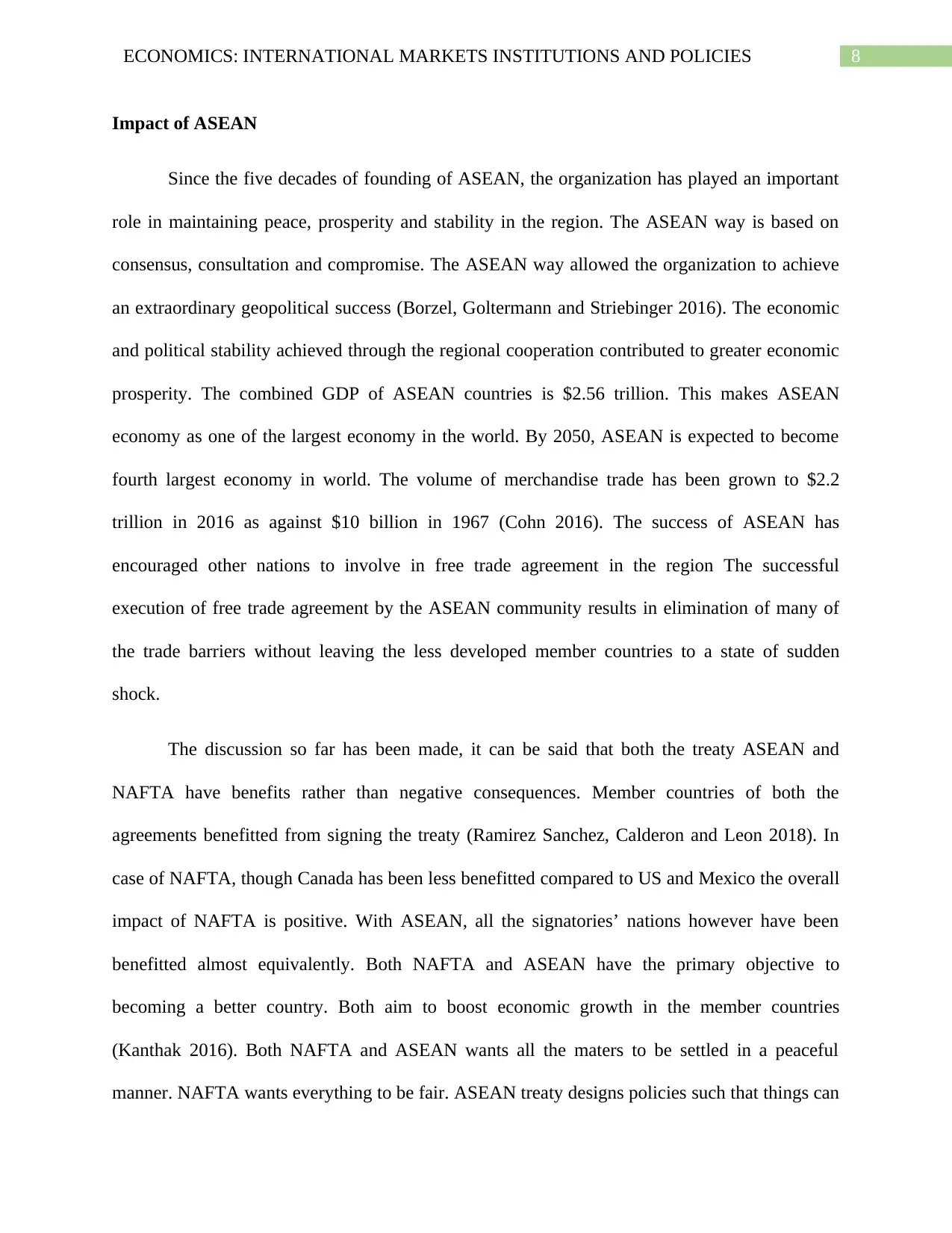
8ECONOMICS: INTERNATIONAL MARKETS INSTITUTIONS AND POLICIES
Impact of ASEAN
Since the five decades of founding of ASEAN, the organization has played an important
role in maintaining peace, prosperity and stability in the region. The ASEAN way is based on
consensus, consultation and compromise. The ASEAN way allowed the organization to achieve
an extraordinary geopolitical success (Borzel, Goltermann and Striebinger 2016). The economic
and political stability achieved through the regional cooperation contributed to greater economic
prosperity. The combined GDP of ASEAN countries is $2.56 trillion. This makes ASEAN
economy as one of the largest economy in the world. By 2050, ASEAN is expected to become
fourth largest economy in world. The volume of merchandise trade has been grown to $2.2
trillion in 2016 as against $10 billion in 1967 (Cohn 2016). The success of ASEAN has
encouraged other nations to involve in free trade agreement in the region The successful
execution of free trade agreement by the ASEAN community results in elimination of many of
the trade barriers without leaving the less developed member countries to a state of sudden
shock.
The discussion so far has been made, it can be said that both the treaty ASEAN and
NAFTA have benefits rather than negative consequences. Member countries of both the
agreements benefitted from signing the treaty (Ramirez Sanchez, Calderon and Leon 2018). In
case of NAFTA, though Canada has been less benefitted compared to US and Mexico the overall
impact of NAFTA is positive. With ASEAN, all the signatories’ nations however have been
benefitted almost equivalently. Both NAFTA and ASEAN have the primary objective to
becoming a better country. Both aim to boost economic growth in the member countries
(Kanthak 2016). Both NAFTA and ASEAN wants all the maters to be settled in a peaceful
manner. NAFTA wants everything to be fair. ASEAN treaty designs policies such that things can
Impact of ASEAN
Since the five decades of founding of ASEAN, the organization has played an important
role in maintaining peace, prosperity and stability in the region. The ASEAN way is based on
consensus, consultation and compromise. The ASEAN way allowed the organization to achieve
an extraordinary geopolitical success (Borzel, Goltermann and Striebinger 2016). The economic
and political stability achieved through the regional cooperation contributed to greater economic
prosperity. The combined GDP of ASEAN countries is $2.56 trillion. This makes ASEAN
economy as one of the largest economy in the world. By 2050, ASEAN is expected to become
fourth largest economy in world. The volume of merchandise trade has been grown to $2.2
trillion in 2016 as against $10 billion in 1967 (Cohn 2016). The success of ASEAN has
encouraged other nations to involve in free trade agreement in the region The successful
execution of free trade agreement by the ASEAN community results in elimination of many of
the trade barriers without leaving the less developed member countries to a state of sudden
shock.
The discussion so far has been made, it can be said that both the treaty ASEAN and
NAFTA have benefits rather than negative consequences. Member countries of both the
agreements benefitted from signing the treaty (Ramirez Sanchez, Calderon and Leon 2018). In
case of NAFTA, though Canada has been less benefitted compared to US and Mexico the overall
impact of NAFTA is positive. With ASEAN, all the signatories’ nations however have been
benefitted almost equivalently. Both NAFTA and ASEAN have the primary objective to
becoming a better country. Both aim to boost economic growth in the member countries
(Kanthak 2016). Both NAFTA and ASEAN wants all the maters to be settled in a peaceful
manner. NAFTA wants everything to be fair. ASEAN treaty designs policies such that things can

9ECONOMICS: INTERNATIONAL MARKETS INSTITUTIONS AND POLICIES
be resolved within countries peacefully and independently. The treaties opened up the door of
new opportunities to handle things in a better and efficient way. The treaties though might differ
in policy designing and execution, the primary goal is the same for both that is to become better
through increasing cooperation.
Despite having same primary objective, ASEAN and NAFTA differ in terms of
promoting a different thing. The ASEAN treaty stressed on promoting peace. It wanted member
countries to behave independently and to be able to solve problems on their own. The focus of
NAFTA treaty on the other hand on creation of free trade zone. NAFTA mainly wanted to boost
economic growth. Parallel to economic growth, ASEAN also targeted to promote cultural
growth. The agreement of ASEAN was mainly set up to strengthen economic cooperation among
Southeast Asian countries and build up a peaceful economy (Anderson 2017). NAFTA on the
other hand targeted to prevent unfair trade and investment practices among the countries. The
NAFTA treaty promotes cooperation among North American countries while ASEAN
encourages association among Southeast Asian countries.
Both the treaties today have been criticized on some grounds. The opponents of NAFTA
claimed that it had moved many of US jobs moved to the south lowering national employment.
In reality the effect of NAFTA on Mexican jobs found to be modest. NAFTA did very little
progress in mitigating the gap in wages between manufacturing in US and Mexico
(usatoday.com 2018). The ASEAN way has been claimed to be very rigid and unable to address
problems at present. Despite the criticism and arising opposition the contribution of NAFTA and
ASEAN in promoting regional integration cannot be denied.
be resolved within countries peacefully and independently. The treaties opened up the door of
new opportunities to handle things in a better and efficient way. The treaties though might differ
in policy designing and execution, the primary goal is the same for both that is to become better
through increasing cooperation.
Despite having same primary objective, ASEAN and NAFTA differ in terms of
promoting a different thing. The ASEAN treaty stressed on promoting peace. It wanted member
countries to behave independently and to be able to solve problems on their own. The focus of
NAFTA treaty on the other hand on creation of free trade zone. NAFTA mainly wanted to boost
economic growth. Parallel to economic growth, ASEAN also targeted to promote cultural
growth. The agreement of ASEAN was mainly set up to strengthen economic cooperation among
Southeast Asian countries and build up a peaceful economy (Anderson 2017). NAFTA on the
other hand targeted to prevent unfair trade and investment practices among the countries. The
NAFTA treaty promotes cooperation among North American countries while ASEAN
encourages association among Southeast Asian countries.
Both the treaties today have been criticized on some grounds. The opponents of NAFTA
claimed that it had moved many of US jobs moved to the south lowering national employment.
In reality the effect of NAFTA on Mexican jobs found to be modest. NAFTA did very little
progress in mitigating the gap in wages between manufacturing in US and Mexico
(usatoday.com 2018). The ASEAN way has been claimed to be very rigid and unable to address
problems at present. Despite the criticism and arising opposition the contribution of NAFTA and
ASEAN in promoting regional integration cannot be denied.
Secure Best Marks with AI Grader
Need help grading? Try our AI Grader for instant feedback on your assignments.
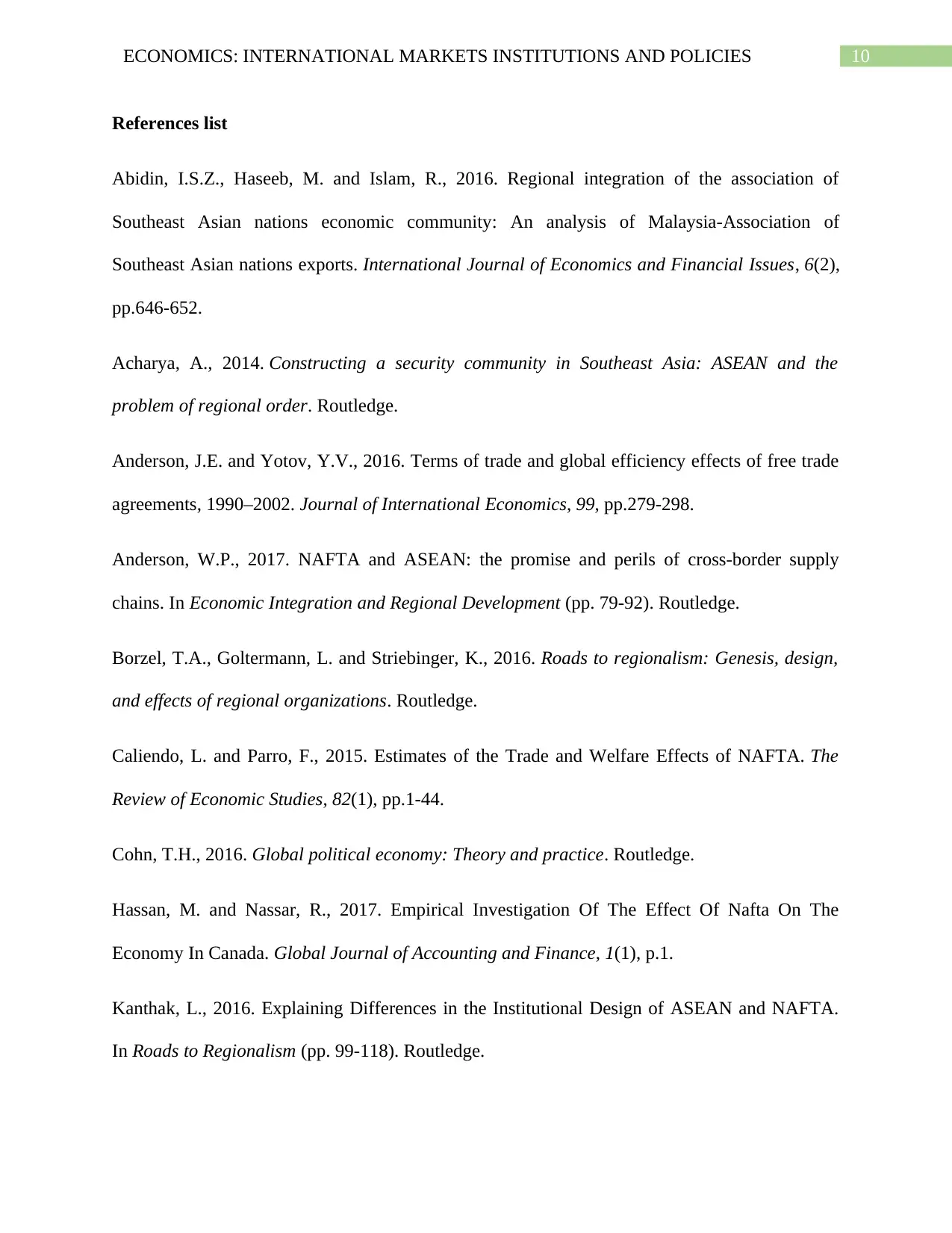
10ECONOMICS: INTERNATIONAL MARKETS INSTITUTIONS AND POLICIES
References list
Abidin, I.S.Z., Haseeb, M. and Islam, R., 2016. Regional integration of the association of
Southeast Asian nations economic community: An analysis of Malaysia-Association of
Southeast Asian nations exports. International Journal of Economics and Financial Issues, 6(2),
pp.646-652.
Acharya, A., 2014. Constructing a security community in Southeast Asia: ASEAN and the
problem of regional order. Routledge.
Anderson, J.E. and Yotov, Y.V., 2016. Terms of trade and global efficiency effects of free trade
agreements, 1990–2002. Journal of International Economics, 99, pp.279-298.
Anderson, W.P., 2017. NAFTA and ASEAN: the promise and perils of cross-border supply
chains. In Economic Integration and Regional Development (pp. 79-92). Routledge.
Borzel, T.A., Goltermann, L. and Striebinger, K., 2016. Roads to regionalism: Genesis, design,
and effects of regional organizations. Routledge.
Caliendo, L. and Parro, F., 2015. Estimates of the Trade and Welfare Effects of NAFTA. The
Review of Economic Studies, 82(1), pp.1-44.
Cohn, T.H., 2016. Global political economy: Theory and practice. Routledge.
Hassan, M. and Nassar, R., 2017. Empirical Investigation Of The Effect Of Nafta On The
Economy In Canada. Global Journal of Accounting and Finance, 1(1), p.1.
Kanthak, L., 2016. Explaining Differences in the Institutional Design of ASEAN and NAFTA.
In Roads to Regionalism (pp. 99-118). Routledge.
References list
Abidin, I.S.Z., Haseeb, M. and Islam, R., 2016. Regional integration of the association of
Southeast Asian nations economic community: An analysis of Malaysia-Association of
Southeast Asian nations exports. International Journal of Economics and Financial Issues, 6(2),
pp.646-652.
Acharya, A., 2014. Constructing a security community in Southeast Asia: ASEAN and the
problem of regional order. Routledge.
Anderson, J.E. and Yotov, Y.V., 2016. Terms of trade and global efficiency effects of free trade
agreements, 1990–2002. Journal of International Economics, 99, pp.279-298.
Anderson, W.P., 2017. NAFTA and ASEAN: the promise and perils of cross-border supply
chains. In Economic Integration and Regional Development (pp. 79-92). Routledge.
Borzel, T.A., Goltermann, L. and Striebinger, K., 2016. Roads to regionalism: Genesis, design,
and effects of regional organizations. Routledge.
Caliendo, L. and Parro, F., 2015. Estimates of the Trade and Welfare Effects of NAFTA. The
Review of Economic Studies, 82(1), pp.1-44.
Cohn, T.H., 2016. Global political economy: Theory and practice. Routledge.
Hassan, M. and Nassar, R., 2017. Empirical Investigation Of The Effect Of Nafta On The
Economy In Canada. Global Journal of Accounting and Finance, 1(1), p.1.
Kanthak, L., 2016. Explaining Differences in the Institutional Design of ASEAN and NAFTA.
In Roads to Regionalism (pp. 99-118). Routledge.
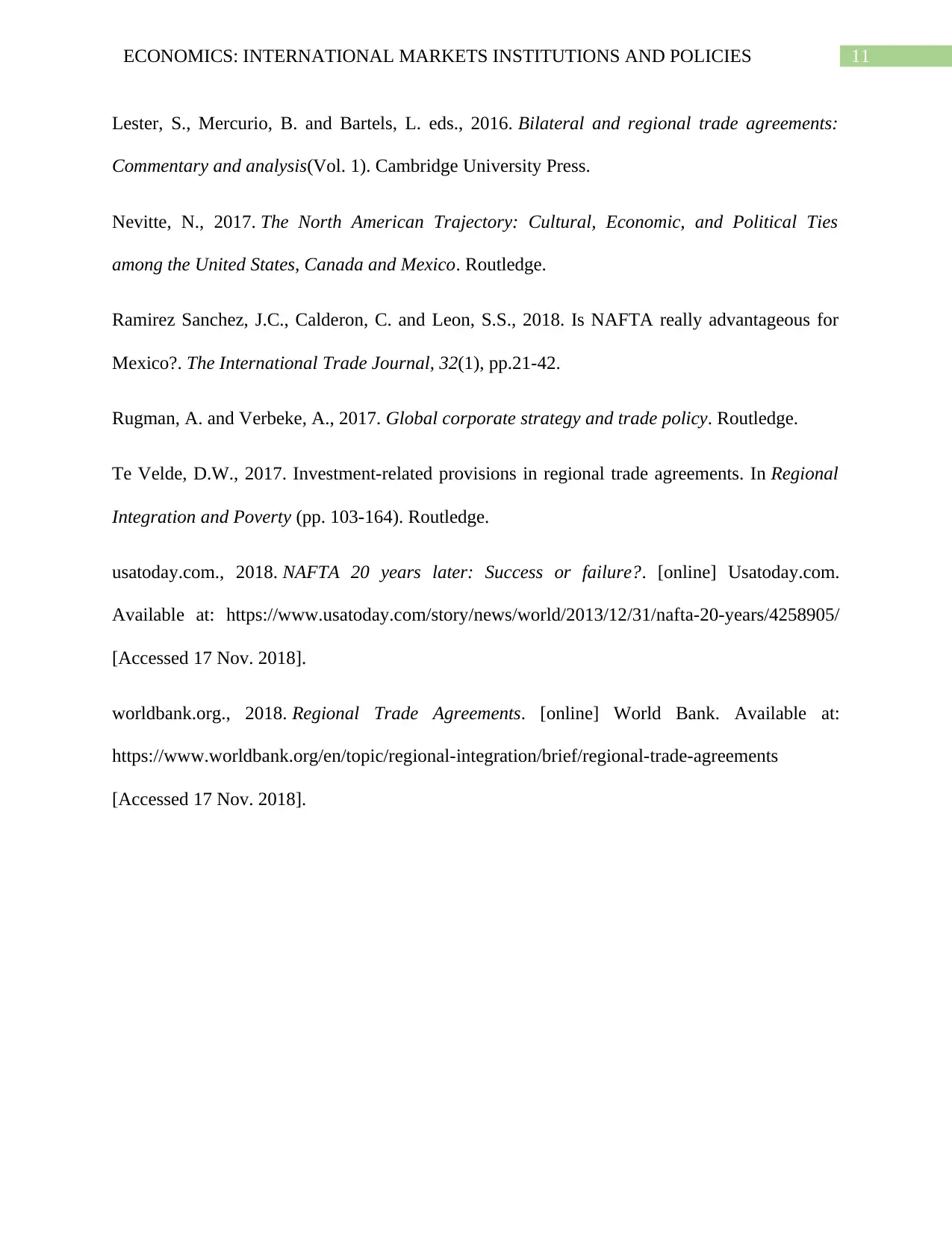
11ECONOMICS: INTERNATIONAL MARKETS INSTITUTIONS AND POLICIES
Lester, S., Mercurio, B. and Bartels, L. eds., 2016. Bilateral and regional trade agreements:
Commentary and analysis(Vol. 1). Cambridge University Press.
Nevitte, N., 2017. The North American Trajectory: Cultural, Economic, and Political Ties
among the United States, Canada and Mexico. Routledge.
Ramirez Sanchez, J.C., Calderon, C. and Leon, S.S., 2018. Is NAFTA really advantageous for
Mexico?. The International Trade Journal, 32(1), pp.21-42.
Rugman, A. and Verbeke, A., 2017. Global corporate strategy and trade policy. Routledge.
Te Velde, D.W., 2017. Investment-related provisions in regional trade agreements. In Regional
Integration and Poverty (pp. 103-164). Routledge.
usatoday.com., 2018. NAFTA 20 years later: Success or failure?. [online] Usatoday.com.
Available at: https://www.usatoday.com/story/news/world/2013/12/31/nafta-20-years/4258905/
[Accessed 17 Nov. 2018].
worldbank.org., 2018. Regional Trade Agreements. [online] World Bank. Available at:
https://www.worldbank.org/en/topic/regional-integration/brief/regional-trade-agreements
[Accessed 17 Nov. 2018].
Lester, S., Mercurio, B. and Bartels, L. eds., 2016. Bilateral and regional trade agreements:
Commentary and analysis(Vol. 1). Cambridge University Press.
Nevitte, N., 2017. The North American Trajectory: Cultural, Economic, and Political Ties
among the United States, Canada and Mexico. Routledge.
Ramirez Sanchez, J.C., Calderon, C. and Leon, S.S., 2018. Is NAFTA really advantageous for
Mexico?. The International Trade Journal, 32(1), pp.21-42.
Rugman, A. and Verbeke, A., 2017. Global corporate strategy and trade policy. Routledge.
Te Velde, D.W., 2017. Investment-related provisions in regional trade agreements. In Regional
Integration and Poverty (pp. 103-164). Routledge.
usatoday.com., 2018. NAFTA 20 years later: Success or failure?. [online] Usatoday.com.
Available at: https://www.usatoday.com/story/news/world/2013/12/31/nafta-20-years/4258905/
[Accessed 17 Nov. 2018].
worldbank.org., 2018. Regional Trade Agreements. [online] World Bank. Available at:
https://www.worldbank.org/en/topic/regional-integration/brief/regional-trade-agreements
[Accessed 17 Nov. 2018].
1 out of 12
Related Documents
Your All-in-One AI-Powered Toolkit for Academic Success.
+13062052269
info@desklib.com
Available 24*7 on WhatsApp / Email
![[object Object]](/_next/static/media/star-bottom.7253800d.svg)
Unlock your academic potential
© 2024 | Zucol Services PVT LTD | All rights reserved.





